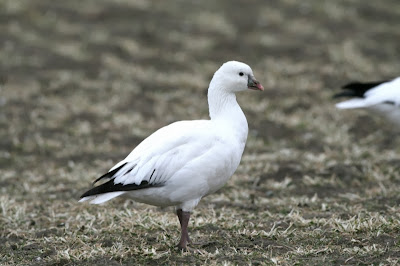 |
| Lift-off at Hagerman NWR, by Lee Hatfield |
Geese have been arriving over the past few weeks to spend
the winter at Hagerman National Wildlife Refuge and the huge flock, estimated
this week at 10,000, is a popular sight for visitors there. Here
are two questions frequently asked, related to the geese, and answers to help
identify the various species.
1. “What do you mean Snow Goose or Ross’s Goose? They all look
the same to me!”
That’s true, until you start looking more closely. Ross’s
Geese are smaller than Snow Geese, but the relative size can be hard to
distinguish when you are looking at a flock of a thousand or more white geese.
Instead, look at the shape of the head and bill.
The Ross’s head is more rounded, with a stubby bill which
appears thicker at the base. The border at the base of the bill is straight and
vertical.
 |
| Ross's Goose, by Rick Cantu |
Here are some memory cues – Snow Goose – sloping forehead; Ross’s Goose – round head.
 |
| Snow Geese, Blue Phase on left, by Rick Cantu |
The dark colored geese with white heads are dark phase Snow
Geese. These were once called the Blue Goose. They will not become white over
time, but are a variation. Dark phase is rare with Ross’s Geese.
A website that is helpful in learning these distinctions is http://www.sdakotabirds.com/diffids/snow_vs_ross.htm.
You may also see a small flock of grayish-brown geese with
white foreheads alongside the white Snow and Ross’s geese; these would be the
Greater White-fronted Geese shown below.
 |
| Photo by Dick Malnory |
Next time you go out to see the geese, take your binoculars,
or borrow some from the Visitor Center, so that you can take a close look
at the head and bill shape and you will find that you can identify the
different species!
The winter waterfowl at the Refuge will be the topic for
both Youth FIRST, on December 7, and Second Saturday, on December 14, when Dr. Wayne Meyer will give a presentation. A guided tour, aboard a TAPS bus, along
Wildlife Drive will be offered on both dates as part of the program.
For more information about activities at the Refuge, please
check our website, http://www.friendsofhagerman.com .
The official site for Hagerman NWR is http://www.fws.gov/refuge/Hagerman.
This post includes information from the post of December 2, 2010, by Dick Malnory.





